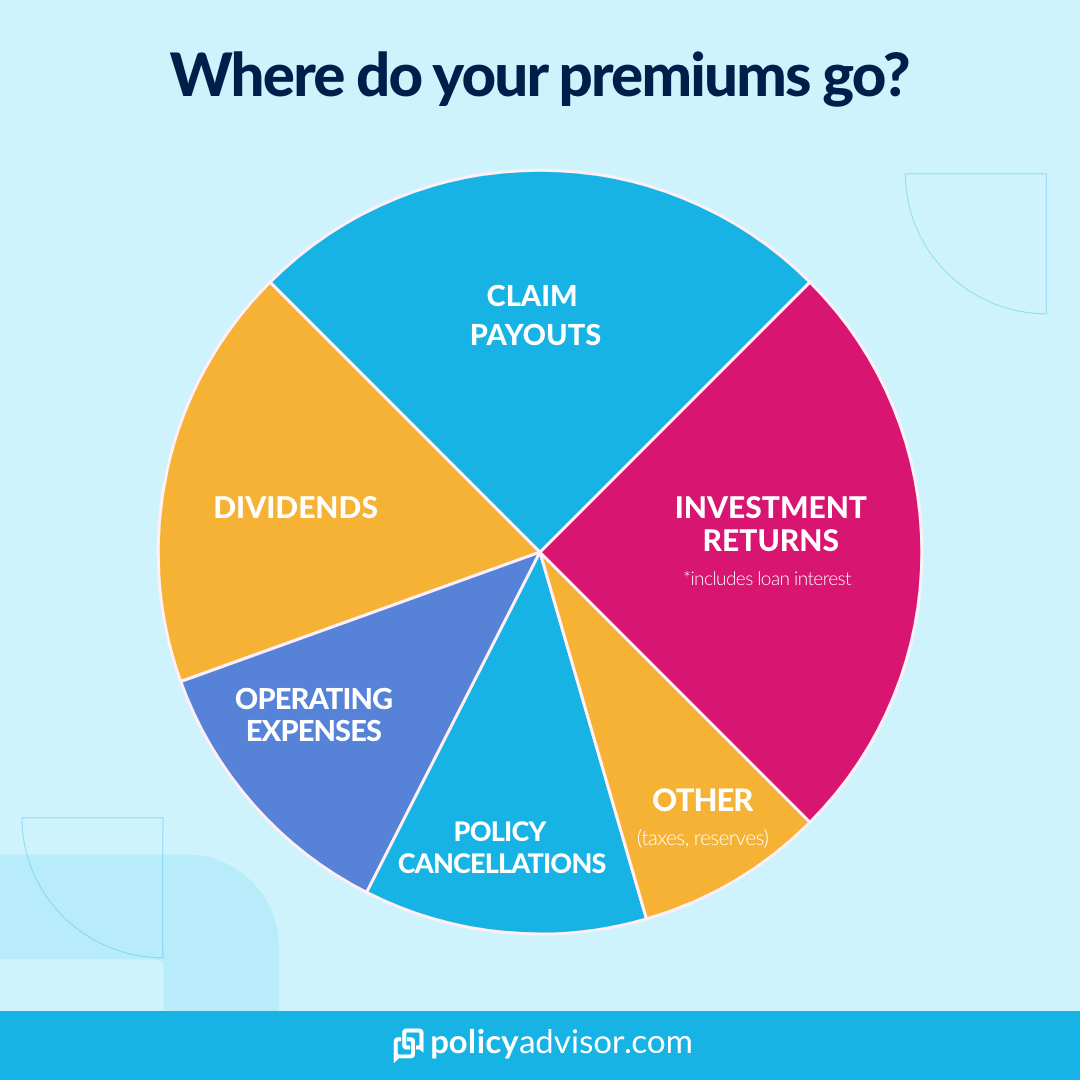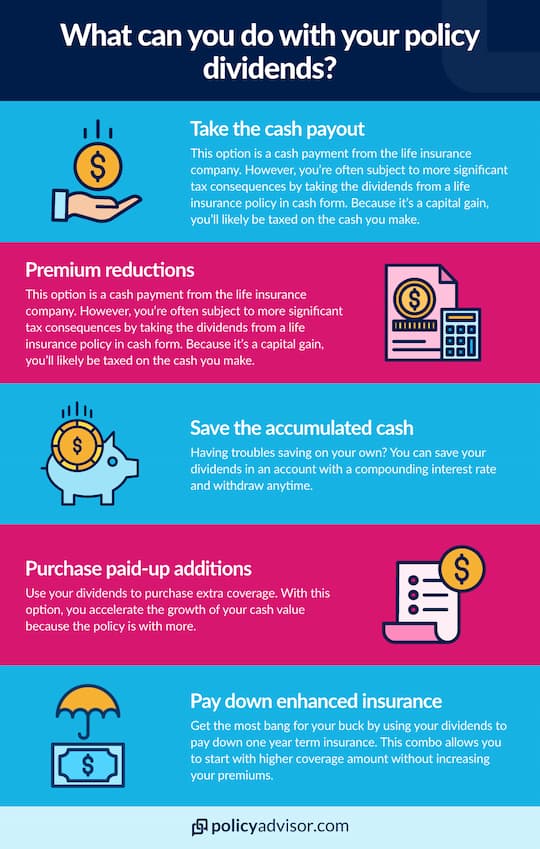- Participating whole life insurance and universal life insurance provide policy dividends
- The size of these dividends depends on your policy type, the investment portfolio, and how the company decides to divide their returns
- You can use these dividends to buy up coverage, reduce your premiums, or take them as cash
- Which life insurance policies have dividends?
- How much is a usual life insurance policy dividend payout?
- What are the dividend options for participating whole life insurance?
- Can I change how I use my life insurance policy dividends over time?
- Are life insurance policy dividends taxed?
- How do I apply for participating whole life insurance?
A whole life insurance policy lets you plan for your death with a guaranteed, lifelong benefit. Some whole life policies offer dividends to policyholders similar to how you receive payouts as an investor in a particular stock.
You can use these dividends in numerous ways. Of course, you can accept it as cash, but some policyholders prefer other options like reducing their premiums, reinvesting it into a larger death benefit, or adding a term policy.
Whole policy dividends are flexible and provide holders numerous options to reinvest their earnings.
Which life insurance policies have dividends?
Participating whole life insurance and universal life insurance have the added benefit of policy dividends. Participating whole life insurance combines a whole life policy’s guaranteed death benefit with the opportunity for tax-deferred cash or investment growth.
The insurer pools the cash or investment portions of participating life insurance policies to invest. These investments can generate surpluses and pay out as dividends to policyholders. Insurers also pay out dividends based on their own financial performance and profits.
Universal life also has this benefit, but with more choice. With a universal life insurance policy, you get to chose a pre-selected investment portfolio, depending on your risk appetite. Some use the dividends generated from these investments to pay their policy premiums. Because you have this choice of risk portfolio, universal life insurance is usually more expensive—and you may be on the hook for premium shortfalls if your choice of portfolio doesn’t perform as expected.
How much is a usual life insurance policy dividend payout?
Dividend payouts vary with policies and insurers. It generally depends on the financial performance of your insurer and their investment portfolios. Dividend payouts can also adjust based on the competitive environment and whether your policy provides a guaranteed or non-guaranteed payout.
Your insurer will release a report with their expected returns, but that does not mean the dividends are guaranteed. It is possible to purchase policies with guaranteed dividends, but they are more expensive (more on this below).
However, even if the company’s investments don’t perform as expected, with participating whole life insurance you won’t have to pay any more premiums than anticipated – you would just get less of a dividend payout.
Financial performance of the insurer
A subset of your insurer’s profitability includes the number of claims they receive. This includes claims for life insurance and the other insurance products that they sell, such as critical illness or disability coverage.
If an insurer receives more claims than anticipated, it could result in poorer than expected performance. If an insurer gets fewer claims than anticipated, it could result in better than expected performance. The latter could then result in higher dividend payouts.
Your insurer’s financial performance also depends on other factors. Expenses in a year could be higher or lower than expected, which affects their bottom line.
Pooled investments
Part of participating life insurance is saving and investing on a tax-deferred basis. Insurers thus pool together premium payments into an investment portfolio. Strong investment performance ultimately leads to surplus cash and higher dividend payouts.
The competition
Insurers compete with one another to attract the premium payments of you and other Canadians. Thus, if one insurance company provides superior dividend payouts, it could push other insurers to dig for extra cash to increase their payouts.
Guaranteed versus non-guaranteed dividends
Dividends can be guaranteed or non-guaranteed, subject to the terms of your policy. You generally face a higher premium if you purchase a whole life policy with a guaranteed dividend. This compensates for the insurer’s obligation to pay a dividend irrespective of their investment portfolio’s financial performance.
By purchasing insurance with a guaranteed dividend, you know the minimum you receive in payouts from the get-go. This certainty is beneficial for people like retirees who need sources of guaranteed income.

What are the dividend options for participating whole life insurance?
Participating whole life insurance can provide dividends in the form of cash, reduced premium deductions, a paid-up additions policy, or an extended/enhanced term policy. Each has its own benefits.
Cash or money back
Sometimes, simple is best, and what’s more accessible than outright cash? However, you’re often subject to more significant tax consequences by taking the dividends from a life insurance policy in cash form. Because it’s a capital gain, you’ll likely be taxed on the cash you make.
Premium reductions
Another straightforward method to receive dividends is through a premium deduction. Typically, this is on a dollar-for-dollar basis — i.e., if your life insurance premium is $100/month and you receive $25/month in policy dividends, then your premiums would now be $75/month.
You also won’t lose any of the benefits associated with your policy or reduce the growth rate of your policy’s cash surrender value.
Paid-up additions
A paid-up addition is an additional whole life insurance policy bought with your original policy’s dividends. This allows you to increase your death or living benefit by increasing your policy’s cash value.
Generally, paid-up additions are positioned as a purchasable life insurance rider that’s structured into your policy when you initially buy it. However, some insurers also let you purchase it later on.
By purchasing paid-up additions, you accelerate the compounding effect of your policy’s cash value and save and invest even more money on a tax-deferred basis.
Dividends on deposit
This is like a savings account—your dividends are automatically deposited into an account at a compounding interest rate set by the insurance company. You can withdraw this at any time, but the interest earned is taxable.
Enhanced insurance
You can also funnel your dividends into a term insurance policy to either top up your coverage for a set term or to create a less expensive way to achieve whole life coverage. Enhanced insurance uses a combination of whole and term insurance to meet your insurance needs. Your policy dividends are used to purchase a combination of paid-up additions and 1-year term insurance. The insurer sets up a base whole life policy and, using the policy dividends, purchases a term policy that tops up your coverage to your desired amount. Using this combination structure usually results in a cheaper monthly premium than if you went for a single whole life policy for the same amount of coverage.
Can I change how I use my life insurance policy dividends over time?
Whether you can change your dividend usage over time depends on your specific policy. If you can’t commit to a single-use, let your insurance advisor know you want a flexible policy that allows you to change how you use your policy dividends.
Changing how you use life insurance policy dividends might have consequences, however. For example, you’re only eligible for paid-up addition or extended-term coverage as long as you maintain the premiums with your dividends. Switching to a cash payout or premium reduction might mean the paid-up addition or extended-term coverage no longer protects you.
Are life insurance policy dividends taxed?
All or part of your policy dividends are taxable if you receive it in cash, or it’s paid out of the policy and accumulating interest. However, redirecting dividends to purchase a paid-up or term policy can avoid these tax consequences and are a popular choice as a result.
If you choose to reduce your premium payments with the dividends, the dividends credited toward your premium are not taxable. But, if your dividend exceeds your premium, and you receive the excess as cash, then that excess is taxable.
How do I apply for participating whole life insurance?
You can start your whole life insurance application by scheduling a call with one of our expert life insurance advisors. At PolicyAdvisor, we can determine the right life insurance that meets your needs — it’s vital to consider your life insurance-related goals before this meeting.
Afterwards, we can guide you through the paperwork. Depending on your age, health, coverage, and other factors, an underwriter determines whether you’re eligible for a policy and at what price.
Our licensed advisors understand the qualifications of over 25+ Canadian insurance companies and can help you find the insurance that works best for your needs while providing the most affordable rates. Schedule a call today!
Permanent life insurance policies have the added bonus of living benefits. A participating whole life or universal life insurance policy allows you to benefit from accessing your cash value and to gain from policy dividends. You can use these dividends to reinvest in the policy, reduce your premiums, and more.


 1-888-601-9980
1-888-601-9980



